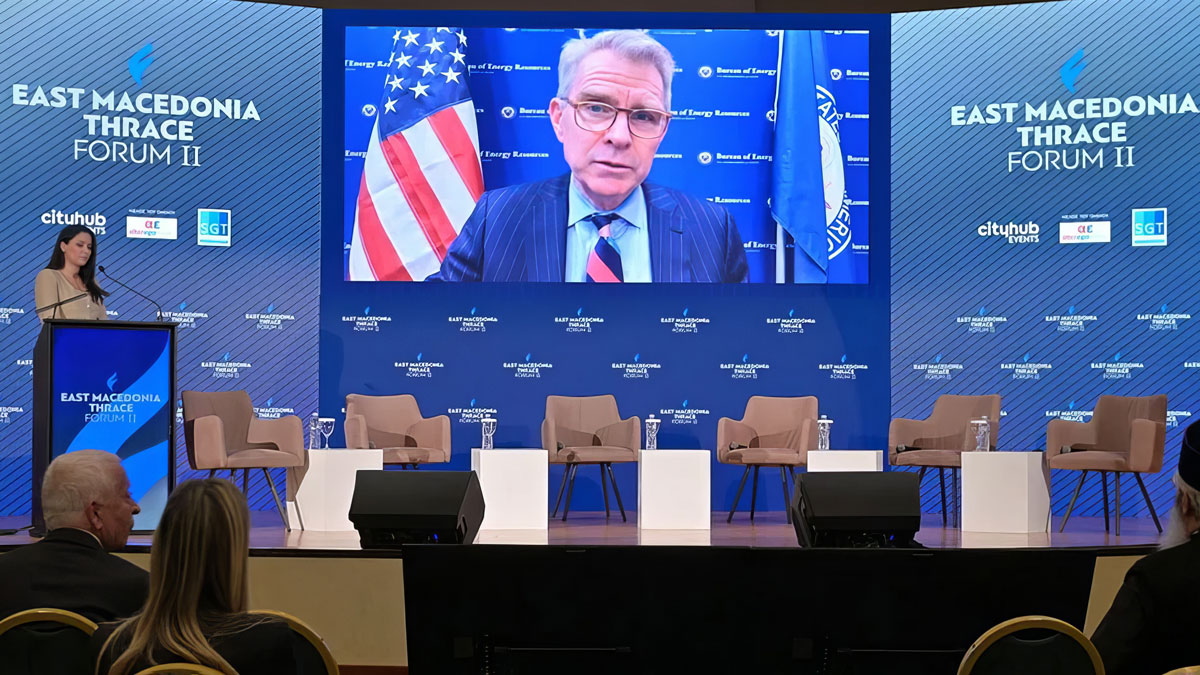Extended Support for the Vertical Corridor
The Vertical Corridor, a European gas pipeline system involving TSOs of seven countries – Greece, Bulgaria, Romania, Hungary, Slovakia, Moldova, and Ukraine, is expected to accelerate Europe’s effort to decouple the continent’s southeast from Russian energy dependence. Besides TSOs from the participating countries, Gastrade, a consortium established by the Copelouzos group for the Alexandroupolis FSRU at Greece’s northeastern port of Alexandroupolis, and ICGB, the consortium behind the Greek-Bulgarian IGB gas pipeline, are also involved in the Vertical Corridor initiative.
US gets involved in promoting the project
The Vertical Corridor is the next visionary project in the region’s energy development, US Assistant Secretary of State for Energy Resources Geoffrey Pyatt told the East Macedonia Thrace Forum, held for the second year in a row in Alexandroupolis.
The US official’s statements on the Vertical Corridor are in line with the position of Transgaz CEO Ion Sterian, who was the initiator of this project that has now taken shape. Ion Sterian has repeatedly advocated for the strategic importance of this gas pipeline, being the one who pushed the neighbouring countries to join this strategic project.
“Using existing infrastructure from Greece up to Ukraine, the Vertical Corridor will allow LNG imported through Greece to fill the vast storage tanks in Ukraine, providing a new source of gas for Central Europe and the Western Balkans, and helping to reduce price volatility along the way,” US Assistant Secretary of State for Energy Resources Geoffrey Pyatt said. He stressed the importance of the project, which will support the EU’s intention to completely disconnect from Russian gas by 2027. According to him, much like the IGB (Greece-Bulgaria Gas Interconnector – ed.) and the Alexandroupolis FSRU (Alexandroupolis Floating LNG Terminal – ed.), the Vertical Corridor will one day be seen as a project whose goal of south-north connectivity is so obvious that the needed investment and political commitment which must start today is scarcely debatable. In this context, the US official noted that both the current US Ambassador George Tsunis and his team in Athens, as well as his own team in Washington, have focused on how they can help promote this visionary project called the Vertical Corridor.
It should be recalled that at the initiative of Transgaz, through CEO Ion Sterian, the strategic meeting of the signatory TSOs of the Memorandum of Understanding for the Vertical Corridor – Transgaz, DESFA (Greece), Gastrade (Greece), Bulgartransgaz (Bulgaria), ICGB (Bulgaria-Greece), FGSZ (Hungary) and, with observer status, Eustream (Slovakia), GTSOU (Ukraine) and Vestmoldtransgaz (Republic of Moldova) – took place on 10 January at the Romanian company’s headquarters. The meeting laid the groundwork for the new Memorandum which was signed on 19 January at CESEC in Athens in the presence of EU Energy Commissioner Kadri Simson. “This corridor will bring prestige to Romania and energy security for Eastern European countries, the Republic of Moldova and Ukraine, but also for Central Europe. Transgaz is a constant and strong supporter of the Vertical Corridor, constantly acting by respecting its commitments and developing a constructive dialogue and close cooperation. Transgaz is confident in the synergy of the Technical System Operators of Greece, Bulgaria, Romania, Hungary, Ukraine, Republic of Moldova, and Slovakia, in the significant impact they can bring in increasing and strengthening the energy security of the respective countries, the region and the European Union. A coordinated development of these countries’ systems and interconnection capacities can contribute to the transformation of the region and the continent in terms of gas supply security and allow Romania to become a pole of economic development in Europe,” Transgaz CEO Ion Sterian stated on this occasion.
Recently, the Greek press wrote that 27 companies, including Romanian ones, have submitted non-binding capacity applications, with a horizon of 2024-2050, for the future trans-Balkan gas corridor, as a phase of the ‘market test’ for the modernisation and expansion of Greece’s gas transmission system by the state-owned company DESFA. The next phase of the ‘market test’ for the modernisation and expansion of the gas transmission system in Greece is the submission of binding bids, which could take place in May 2024.
The full activation of the Vertical Corridor, through the appropriate upgrading of the networks in the mentioned countries, will allow gas to be transported from south to north and vice versa through the European natural gas and LNG transmission systems, exploiting the increased capacities of new and developing FSRUs in the area. This potential can be further expanded by using the mentioned infrastructure for renewable gases and hydrogen.
Bulgaria has adopted the decision on the Vertical Corridor
The Bulgarian Parliament recently adopted a decision on the Vertical Corridor initiative of natural gas transmission operators from Bulgaria, Greece, Romania, Hungary, Slovakia, Ukraine, and Moldova, offering the possibility to transport additional volumes of natural gas from diverse and reliable sources.
The draft decision asks the energy minister to study the possibility of European funding for the implementation of three gas transmission projects, whose indicative value is BGN 825 million excluding VAT. It is also planned that by 1 May, the energy minister will increase the share capital of Bulgartransgaz EAD by BGN 200 million, the funds following to be used for the preparation and implementation of projects.
The decision provides for the expansion of Bulgartransgaz EAD’s gas transmission infrastructure and the implementation of the following projects: Increasing the natural gas transmission capacity at the interconnection point Kulata/Sidirokastro from Greece to Bulgaria; Increasing the natural gas transmission capacity at the Negru Voda/Kardam interconnection point from Bulgaria to Romania; High-pressure gas transmission infrastructure to supply consumers in the East Maritsa region.
The Energy Committee report states that the implementation of these projects is of great strategic importance for two reasons: the imminent suspension of Russian gas transit through Ukraine as of 1 January 2025; the fact that the existing infrastructure of Bulgartransgaz EAD does not allow for the full replacement of Russian gas transited through its network, while the projects will provide the network with the technical capability to transport increasing quantities of natural gas from a variety of reliable sources.
To meet gas demand in Hungary, Slovakia, the Czech Republic, Austria, Croatia, and Italy, which receive gas via Ukraine, competing routes are being considered through LNG supplies via routes from Southern, Northern and Western Europe and an increase of up to 4 billion cubic metres in supplies from Russia via the Turkish Stream offshore pipeline.
According to Bulgarian media, after Ukraine’s accession to the Vertical Gas Corridor initiative, it is not only a competitive solution but also a solidarity-based solution to secure gas supplies to Europe. The implementation of these projects by Bulgartransgaz EAD will allow the utilisation of the capacities of Ukraine’s pipelines and gas storage facilities and preserve the role of Ukraine’s gas infrastructure for European energy security, the committee’s report further states.
Kiev gives up agreement with Moscow
Officials in Ukraine have said they had no plans to extend a five-year agreement with Russia’s Gazprom Group on the transit of Russian gas to Europe or to sign another. Under an agreement agreed between Moscow and Kiev in 2019, Russia pays Ukraine to export gas to Europe through its pipeline network. The agreement expires at the end of December 2024.
“I can confirm that we have no plans to enter into any additional agreements or extend this (current) agreement,” Ukrainian energy minister German Galushchenko said. Ukraine has an annual gas consumption of about 20 billion cubic metres and the Vertical Corridor will be able to meet part of its consumption needs.







